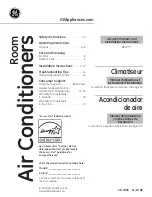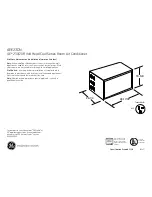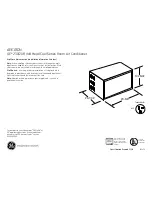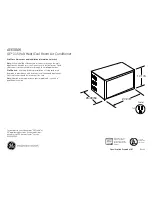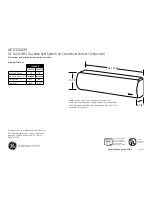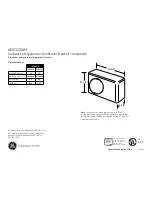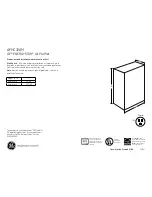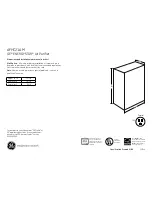
VIII. TO CLEAN CONDENSATE DRAINS
Clean all drains and drain pans at the start of each cooling
season. Check the flow by pouring water into the drain.
SERVICE
WARNING:
When servicing unit, turn off all electric
power to unit to avoid shock hazard or injury from ro-
tating parts.
CAUTION:
Do not vent refrigerant to atmosphere
when servicing unit. Recover refrigerant during sys-
tem repair or unit removal.
I. DIAGNOSTIC CODES
This unit is equipped with a microprocessor control which con-
tinuously monitors the operation of the unit. If an opera-
tional fault is detected, a fault is indicated by the flashing of
the green ‘‘UNIT ON’’ light on the front of the fan coil unit. A
red LED (light-emitting diode) indicator light, located on the
control board in the control box of the indoor unit, will emit
a flash code which can be used to troubleshoot a system prob-
lem. The control will continue to monitor the unit and, if the
conditions which cause the fault are cleared, the unit will re-
turn to normal operation. If the fault code is present for
5 cycles of the unit, the unit will be locked out and the alarm
is indicated by the flashing of the green ‘‘UNIT ON’’ light on
the front of the fan coil unit.
To access the LED indicator light, remove the front cover of
the unit by removing the 3 screws holding it in place.
If the LED indicator light continuously flashes on for one sec-
ond, then off for one second, the control is functioning prop-
erly and no fault is present. A fast flashing LED indicates
that a fault has been detected. Table 7 lists the number of
quick flashes and the associated fault. If the system does not
operate and the LED indicator does not flash, either the power
to the control board is off, or the control board has failed.
Table 7 — System Fault Codes
NO. OF QUICK
LED FLASHES
SYSTEM FAULT
2
Room Air Thermistor
3
Indoor Coil Thermistor
4
Outdoor Coil Thermistor*
5
Compressor Malfunction
6
Reversing Valve Malfunction*
7
Outdoor Air Thermistor*
8
Indoor Fan Failure
9
Discharge Air Thermistor
LED — Light-Emitting Diode
*Heat pump systems only.
NOTE: If the LED light continuously flashes on for one second, then off
for one second, the control is functioning properly and no fault is present.
II. SYSTEM TESTS
System tests listed below are performed continuously by the
microprocessor. If a fault is indicated, then the system allows
only limited operation until the problem is resolved. If the
problem resolves itself, then the code is cleared and opera-
tion resumes.
A. Thermistor Tests
Each thermistor is tested for high limit out of range (shorted
condition) and low limit out of range (open condition). If the
thermistor is out of range, the fault status indicator comes
on and the LED flashes the appropriate fault code.
B. Compressor Failure
If the System is in Cooling or Dehumidification Mode
After 5 minutes of operation, if the temperature of the indoor
coil is not 4° F less than at the time the call for cool-
ing started, then a compressor failure is indicated on the re-
mote controller LCD display.
If the System is in Heat Pump Heating Mode (538B Only)
After 5 minutes of operation, if the temperature indicated by
the outdoor coil thermistor is not 4° F less than at the time
the call for heating started, then a compressor failure is
indicated.
C. Reversing Valve Failure
If the System is in Cooling or Dehumidification Mode
After 5 minutes of operation, if the temperature at the in-
door coil is 4° F more than at the time the call for cooling
started, then a reversing valve failure is indicated.
If the System is in Heat Pump Heating Mode
After 5 minutes of operation, if the temperature indicated by
the outdoor coil is 4° F more than at the time the call for
heating started, then a reversing valve failure is indicated.
III. SYSTEM SAFETIES AND INTERLOCKS
A. Indoor Fan Failure
If the indoor fan rpm shows greater than 800 rpm for 30 sec-
onds with the fan in the off mode, then this test indicates an
indoor fan failure. Also, if the indoor fan rpm is greater than
1700 rpm for 30 seconds, then this test indicates an indoor
fan failure.
B. Compressor Short-Cycling Protection
There is a time delay of 3 minutes between compressor turn-
ing off and turning back on.
C. Indoor Coil Freeze Protection (Cooling or Dehumidifica-
tion Mode Only)
If the indoor coil temperature is less than or equal to 32 F for
10 minutes after the compressor has started, then the com-
pressor and outdoor fan are turned off. The indoor fan con-
tinues to run at the user-selected speed until the indoor coil
reaches 44 F. At that time, the compressor and outdoor fan
will restart.
D. Indoor Coil High-Temperature Protection (Heat Pump Sys-
tems Only)
If indoor coil temperature is greater than or equal to 135 F,
the outdoor fan shuts down. The outdoor fan will restart au-
tomatically when the indoor coil temperature drops to 120 F.
—14—
























